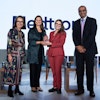Corporate Social Responsibility

Business is the most trusted institution and can play a key role in solving our hardest problems.
Now more than ever, companies are putting corporate social responsibility (CSR) at the core of everything they do to support their employees, customers, and communities.
Spotlight
The Citizens Awards recognize businesses for their leadership in solving the world’s biggest challenges. Awards are given in nine categories, honoring the most innovative and impactful corporate citizenship programs, from civic engagement and economic opportunity to education and disaster response. Apply by June 14, 2024.
We harness the power of business to create solutions for the good of America and the world. In celebration of Women’s History Month, we gathered leaders from across sectors to discuss solutions powered by the business community and its partners that touch the lives of women and children across the world.
Press Release
Medtronic, Veris Residential, UPS, Tru Earth among winners of awards program celebrating the best in corporate citizenship, and Greater Vancouver Chamber receives inaugural Civic Engagement Award
Programs
For years, businesses have delivered critical solutions to big problems and helped strengthen communities when it matters most.
Our work focuses on supporting the business community in their efforts to accelerate innovation, and expand opportunity, resilience, and prosperity for communities in America and around the world.
Latest Content
Learn more about the IBM Sustainability Accelerator, winner of the 2023 Citizens Award for Best Sustainability Program, from Vice President and Chief Impact Officer, Justina Nixon-Saintil.
Shannon Favazza, Principal and Head of Analytics at Edward Jones, discusses the importance of empowering women in leadership positions in the private sector.
The 14th Annual International Women's Day Forum served as a pivotal platform for critical discussions addressing the challenges and opportunities in the empowerment and safety of women and girls highlighting the essential role of multi-sector partnerships in supporting women and children amidst global challenges.
Sasha Nicholas, associate manager of early childhood education, reflects on key takeaways from the panel, "Piecing Together Childcare Solutions," an engaging conversation held at the 14th Annual International Women's Day Forum.
Rooted in the Foundation's commitment to catalyzing powerful private-public partnership opportunities, this annual event featured thought-provoking and actionable insights from esteemed speakers paving the way to a more empowered future for women and girls.
This January, 19 small business owners in San Antonio graduated from BizConnect, a program designed to bring development and mentorship resources to small businesses in economically distressed areas to help strengthen local communities.













